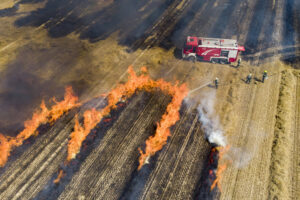Az Őrségben, vele együtt Őriszentpéter egy jelentős részén is – a lakott területeket nem számítva – erdőkkel találkozhatunk. Az állományokat meghatározóan erdeifenyvesek alkotják, melyek gyakran gyertyánnal, különböző tölgy fajokkal elegyednek. Önálló foltokban úgynevezett pannon gyertyános-tölgyesek is meg találhatóak, melyek természetvédelmi szempontból minden képpen a legértékesebbek. Ezek után feltételezhetjük, hogy madaraink legnagyobb része az erdőkhöz kötődhet, ahol a talajszinttől, a fák törzsein át egészen a lombkoronáig megtalálhatják a számításaikat. Legtöbben a harkályokra – vagy más néven fakopáncsokra – gondolunk, amikor egy odúról beszélünk. És ezzel nem is tévedtünk, hiszen létrejöttük zömében valóban nekik köszönhető. Őriszentpéteren, a hazai nyolc harkályfajból hat fordul elő. Legtermetesebb közülük a csaknem varjú méretű fekete harkály, a legkisebb pedig az alig veréb nagyságú kis fakopáncs. Azonban nem csak a harkályok, hanem számos más madárfaj is használja a harkályok odúit. Bár a harkályokkal rokon nyaktekercs, és a csinos megjelenésű búbos cinege – melynek az Őrségben országos szinten is jelentős állománya él – esetenként hozzálát az odúkészítés műveletéhez, további négy cinegefaj, valamint az örvös légykapó, a csuszka, a seregély és a mezei veréb egyszerűen csak beköltöznek ezekbe.

ln the Őrség region and also in a considerable part of Őriszentpéter – apart from the inhabited areas – we can come across forests. Most of the stands are comprised of coniferous woods often mixed with hornbeam and various oak species. There are also separate patches of so called Pannonian mixed hornbeam and oak forests that are by any means the most valuable from the nature conservation point of view. Based on this wecanassume that most of our birds can live in forests, finding their habitats everywhere from the ground level through the tree trunks up tothe foliage of trees. When talking about a wood cavity, most of us might think of woodpeckers or, as they are also called, great spotted woodpeckers. And by doing so, we are not mistaken, because the existence of wood cavities can mostly be thanked to these birds. At Őriszentpéter six of the eight woodpecker species living in this country can be found. The biggest of all of them is the black woodpecker having the size of a crow, while the smallest one is the lesser spotted woodpecker that hardly reaches the size of a sparrow. lt is not only the woodpeckers themselves that use their own wood cavities, but a number of other bird species also occupy them. Although the wryneck which is a relative of the woodpeckers and the pretty-looking crested tit – that lives in a considerable population in the Őrség region also by national standards – occasionally embark on the operation of making a cavity, four other species of tit and the collared flycatcher, the wood nuthatch, the starling and the meadow sparrow would simply move in these cavities.









